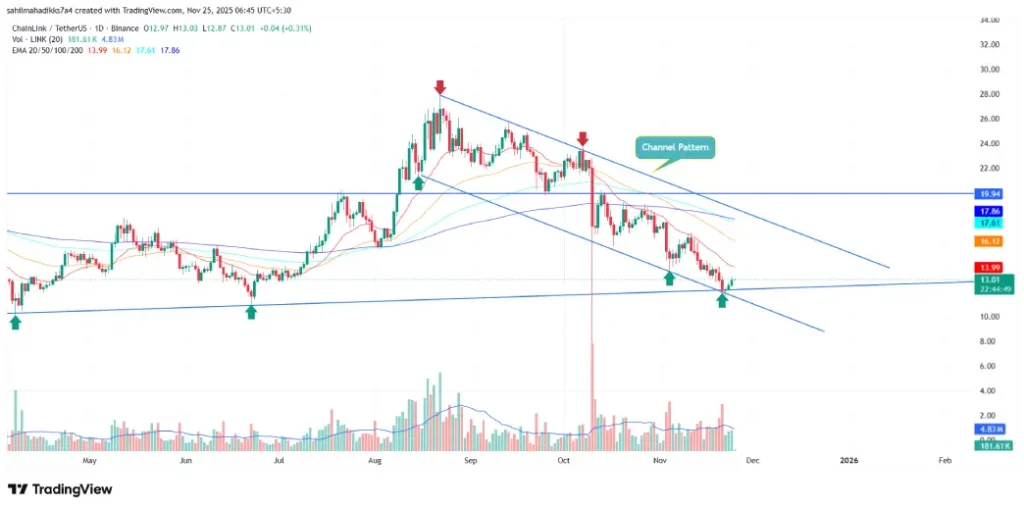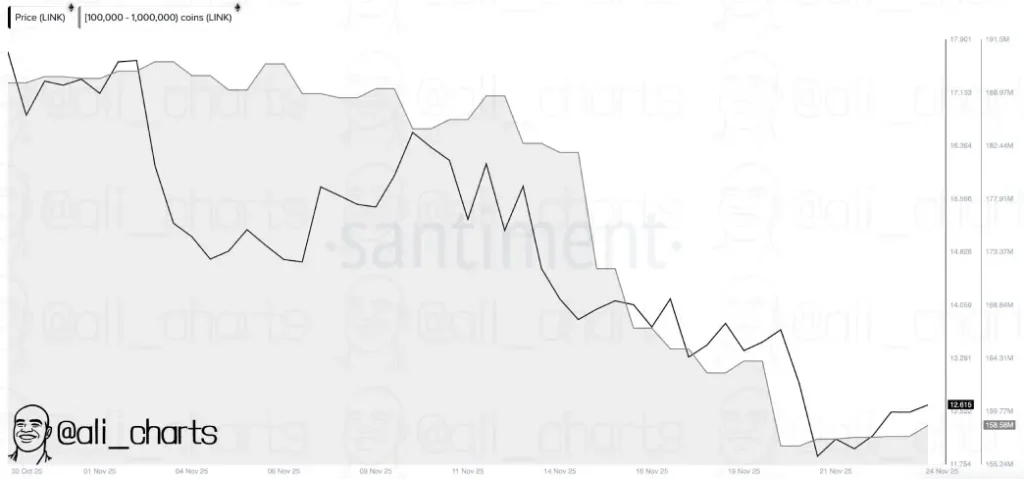- Chainlink price holds key support within the formation of a falling-wedge pattern.
- On-chain data shows that whale investors have sold around 31.05 million LINK tokens in the last three months.
- Open interest tied to LINK futures shows a steady decline from $730.8 million to $510.3 million
LINK, the native cryptocurrency of the decentralized Oracle Network Chainlink, jumps 3.91% during Monday’s U.S. market hours to trade at $13.02. The buying pressure followed a relief rally in the crypto market as Bitcoin rebounded from $80,000. However, the Chainlink price is poised to face two key resistance tests at $14 and $17 amid renewed selling pressure from large investors, signaling a risk of further downtrend.
LINK Rises to $13 Despite Weak Whale and Derivatives Support
In the last three days, the Chainlink price experienced a bullish rebound from $11.74 to the current trading value of $13.05, registering a gain of 11%. The pickup began right after Bitcoin stabilized above the $80,000 mark and brought some confidence back across major altcoins. The move received further support after investors responded to changing expectations regarding U.S. monetary policy after several Federal Reserve officials signaled support for a softer stance at the upcoming December 9-10 FOMC meeting.
Remarks from New York Fed President John Williams provided clues that policy might keep making adjustments towards a neutral setting again, whereas Governor Christopher Waller stated a 25-basis-point lower could be suitable as a result of easing inflation pressures. These statements added fuel to speculation that the tightening cycle may be nearing its end, fueling sentiment-driven buying across crypto markets.
However, the Chainlink price could struggle to drive a sustainable uptrend amid a lack of retail and whale support.
According to a recent tweet from market analyst Ali Martinez, 31.05 million LINK have been sold or redistributed by whales over the past three weeks. Historically, the selling pressure from these large investors has coincided with major market tops and accelerated corrections in price, signalling a risk for extended corrections in LINK.
Derivative behavior tells the same story. Open interest associated with Chainlink futures has continued to cool since the liquidation event that was recorded on October 10. According to Coinglass data, the OI value has shown a slow and yet steady downsizing from $730.85 million to nearly $510.3 million, registering a 30% loss.
This decrease indicates that the traders are exiting their leverage exposure from the market amid the current price uncertainty. This move signals subdued speculative conviction, withdrawing a key force from the market to bolster price movement.
The combination of rising spot price, coupled with eschewing participation of major players, suggests a recovery that is driven more by macro sentiment but not by strong inflows or structural demand.
Chainlink Price Holds Key Support Within the Channel Pattern.
By press time, the Chainlink price shows a 3.5% intraday jump, currently trading at $13.0. When analyzed in the daily chart, this upswing is positioned at the support trendline of a falling-wedge channel pattern.
The chart setup is characterized by two parallel falling trendlines, which act as dynamic support and price for traders. The recent history of this pattern shows that a retest of the bottom trendline has often bolstered buyers to recoup the bullish momentum for a potential rebound.
Thus, the current recovery in trading price is speculated to gain momentum and jump nearly 23% to hit the overhead trendline at $17.86. However, the price jump today is backed by low trading volume, indicating a lack of conviction from buyers.
Therefore, the LINK price could struggle to breach the immediate resistance of the 20-day EMA slope, which drives the current high momentum rooted in this asset. Similarly, the upper boundary of the China title stack has a major resistance against bias to drive a sustainable recovery.

Therefore, if the coin sellers decide to defend this register, the current correction could prolong for the coming weeks to months.


